
A decaying relic, kept in a mockery of life by foul alchemy and a perpetual state of rage born of ancient esoteric grudges?
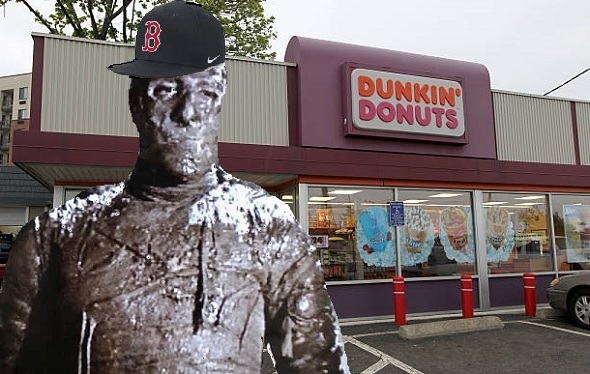
Oh, he’ll do just fine in these parts.
Recommended listening: More regional ghosts.

A decaying relic, kept in a mockery of life by foul alchemy and a perpetual state of rage born of ancient esoteric grudges?

Oh, he’ll do just fine in these parts.
Recommended listening: More regional ghosts.
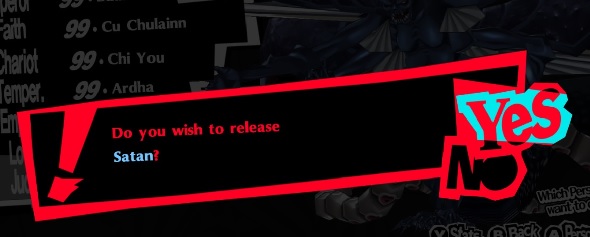
It’s not as if things could get any worse out there, so why not?
Recommended listening:
Vampires and werewolves may be frightful, but they lack the gnawing existential elan of the terrors of parenthood.
Besides all the anxieties about perils which might afflict your offspring, there are more subtle chills — namely the recurring fits of angst over whether the example you’ve tried to set or lessons you’ve tried to impart have found any purchase within the child’s psyche.
The feeling peaks during the kid’s adolescent years, with their surly, eye-rolling onslaught of oppositional behaviors and acts of pointless rebellion. It’s a script as old as time and countless words have been expended to explain how expected and unremarkable these behaviors are, and how they’re part and parcel of the maturation process, but that received wisdom does do a lot good as the process unfolds and shitty teenitude is in full flower.
“Where did I go wrong?” you wonder. “Did they pick up anything we’d tried to lay down for them over the years?”

…and then the kid goes and sneaks a kitten into the house, and you realize that all your behavior modeling wasn’t just pissing into the wind.
Like mother, like daughter.
Recommended listening:
The unconvincing gorilla suit was a staple of stage and screen dating back to at least the late 19th Century.
Need an exotic menace for an old dark house? Someone to send a slapstick ensemble into a state of comedic terror? A zany bit of zest for a struggling sitcom? Just throw someone with the right dimensions and pantomime chops into a tatty looking ensemble of faux fur, visible eyeholes, and disturbing pleather plates representing the chest and abs of the Grade Z ape.
That such a sorry assemblage could be a thing of wonder of menace might seem like a mystery, but the short answer is “because audiences were acclimated towards accepting it,” — at least up until the second half of the 1960s, when the astounding practical effects in Planet of the Apes and 2001 brought the simulated ape game to a whole new level.
Old school gorilla suits hung on in comedic circles for a while longer, though even those had embraced the new technology by the dawn of the 1980 outside everything except low grade kiddie fare and the deliberate affectations of Jim Henson’s workshop.
That’s why I was both delighted and surprised to discover that “Hatred Unto Death,” the main segment of the final Night Gallery episode, served up a classic simulated simian in May 1973.
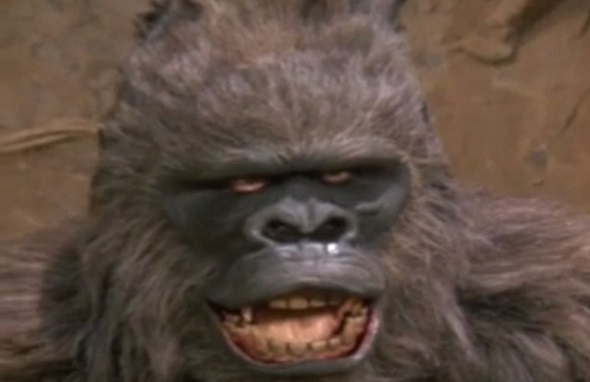
Because nothing screams “terror” like a creature you’d normally see swooning over Mrs. Howell’s perfume, chasing around the crew of the Seaview, or trying to talk Serena into changing him back into Darrin Stephens again before Samantha gets home from shopping.
Recommended listening:

“One look at his bookshelf and I knew the relationship was going to be a non-starter.”
“I don’t blame you. Sounds like a huge red flag.”
“I mean, he had the Teasdale translation of the De Vermis Mysteriis, for Dagon’s sake! Couldn’t even spring for the Armitage edition! And his copy of the Necronomicon looked like it came from a mall bookstore!”
– overheard at the Happy Shoggoth Taphouse, Innsmouth MA
Recommended listening:
During the pandemic years, I took a very holistic and intensive approach to Spooky Month. Having a surfeit of time to kill, I filled with with a robust roster of appropriately themed movies, TV shows, videogames, comics, prose, and old time radio shows. It was a glorious time to discover, re-discover, revisit, and generally wallow around in groovy ghoulish retrotrash.
Now that things are back to “normal” (by which I mean “unchecked spread mitigated somewhat by vaccination”), I don’t have the free time for such an immersive approach, but I have made a dedicated effort to indulge in some creepy comforts on a daily basis. My 27th (!?!) annual October playthrough of Castlevania: Symphony of the Night is currently in progress, I’ve pulled a few cherished horror fiction anthologies from the shelves, and I have been making an effort to squeeze at least one spooky flick into my daily schedule.
I did consider making the procession of cinematic horrors the basis for this year’s countdown, but realized that it would box me in of days when I could barely manage a quick shitpost and the logistics would require a “one-ahead” approach to viewing and that all sounds suspiciously close to actual work.
What I will do, however, is drop a weekly breakdown of capsule summaries/reviews/factoids/snarky bullshit covering the films I’ve watched thus far.

Graduation Day (1981): Christopher George! Michael Pataki! Patch McKenzie! Linnea Quigley! Vanna White? A zero budget teen slasher with death by a bladed football, an excruciating disco theme song, and a performance by L.A. glam/new wave band Felony at a roller boogie party.

Honestly, the glimpses of authentic material culture from the dawn of the 1980s was the real draw for me here.
Curse of the Faceless Man (1958): A stock template mummy movie, with the requisite lumbering monstrosity and tragic tale of doomed love and reincarnation. The big twist, such as it is, is that instead of a cloth-swaddled corpse from Ancient Eqypt, the titular Faceless Man is a lava-encrusted gladiator discovered in the ruins of Pompeii. Richard “Oscar Goldman” Anderson is in there as a square-jawed scientist whose stiffness rivals the ambulatory ash-heap terrorizing the Naples countryside, and there’s also an unseen narrator doing the always amusing bit of explaining to audiences what they have clearly seen depicted on the screen.
There’s nothing in it I haven seen done better in a dozen other movies, but it’s only an hour long and doesn’t overstay its cheap trash thrills welcome.

Mortuary (1982): Christopher George returns, and this time his real-life wife Lynda Day George is with him! Also a disturbingly young Bill Paxton! And some great location shooting at a real 1982 SoCal roller rink!
This is a weird one. There are teen slasher elements, but it’s not a teen slasher. There are Hitchcock-inspired suspense elements but the what mystery there is can be figured out within the first twenty minutes. By accident or design, it felt like an American attempt to reverse engineer an Italian giallo flick. It doesn’t quite get there, but it was still an interesting and occasionally disturbing experience.
Did I mention there are scenes shot at a real life 1982 roller rink?

Dark Intruder(1965): Another sixty-minute quickie, this time a failed TV pilot repurposed as a cinematic feature. A supernatural serial killer is on the loose in 1890 San Francisco, and playboy supernatural investigator Leslie Nielsen is on the scene!
It’s not a bad way to kill an hour as long as you go into it right-sizing your expectations. Despite how it was released, it’s very much a made-for-TV product, right down to the presence of Werner Klemperer in a supporting role. There are no actual scares to be found, but some nice period atmosphere and suspenseful moments. Nielsen plays the heroic lead with caddish aplomb, and accomplishes the exceptional feat of being the smarmiest member of a cast that also included Peter Mark Richman.
Recommended listening:
As I mentioned in my last post before settling back into hiatus, one of my joys of the pandemic era experience was discovering the Model 2 emulator, coded to run games made for Sega’s (surprise, surprise) Model 2 hardware.
While I game had originally wanted to play — Virtual On — was tangled up in an still-unresolved control mapping bug, the thrill of exploring the rest of the platform’s library quickly eclipsed any disappointment I might have had on that front. Even better, the emulator itself went above and beyond in trying to adapt the assortment of funky control schemes used by the various arcade cabinets into something that felt fluid and intuitive via mouse, keyboard, and USB joypad.
Lightgun games in particular did well by this, with default mouse mapping and a visible cross hair to assist with aiming. After a little fiddling in the test menu’s calibration mode, and I was good to go — and I go I did to…

…THE HOUSE OF THE DEAD.
The game is basically Virtua Cop, but with zombies and some so-bad-it’s-amazing voice acting. The switch to textured polygon models allowed for ragdoll effects and target damage deformation. There are branching paths based on shooting/missing less-than-obvious targets over the course of the game, tricky boss battles, cheap jump scares, and plenty of squicky gore. It, alongside Resident Evil, was a major factor in the resurgence of popcult zombie-mania which persists through the present day.

I had/have the North American version of the Sega Saturn port of the game, released in limited quantities during the console’s final days and now worth a frankly embarrassing amount of cash. I wasn’t much of an arcade rat during the Model 2’s heyday, so the blurry textures, polygon clipping, and inconsistent frame rates of the Saturn’s Model 2 ports shaded my memories of the games in general. Consequently, I was thrown for a loop when I witnessed just how slickly polished and smooth the associated titles were on simulated original arcade hardware.
The real reason House of the Dead and other Model 2 suite titles became staples of COVID era existence, though, is that there were designed to be short dose experiences, played out a couple of quarters and a few minutes at a time. It made them ideal for breaking up the monotony of lockdown routines, especially as a moment when I’d just quit Destiny 2‘s live-service hamster wheel cold turkey.
Got five minutes before switching the loads in the washer and dryer? Roll the mouse around a little and blast some zombies.
Need to clear my thoughts after finishing an intensive work project? Roll the mouse around a little and blast some zombies.
Just knocked off four chapters in a book I’ve been reading, and am feeling a little restless? Roll the mouse around a little and blast some zombies.
The same could also be applied to Last Bronx, Sega Rally Championship, Top Skater, and Sega Water Ski, but House of the Dead had a slight advantage in that it didn’t require the same level of concentration to enjoy — even by arcade game standards — and it could be played without having to hook up a joypad. That’s almost certainly why it still gets frequent play from me while other Model 2 faves have become more infrequent events on my schedule.
It’s also probably why I started referring to my cat Mister Gray the Winter King as “G.”
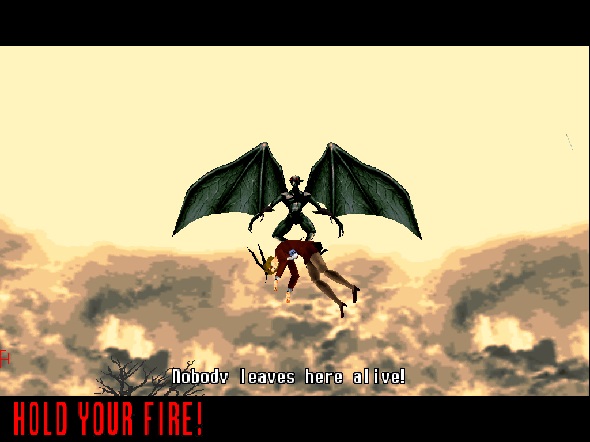
Recommended listening: When you’re in Curien Mansion and see the screen turn red, when you run out all out of tokens…
(excerpts from Van Nielsen’s Field Notes on Prime-Time Draculas)

Rollin Handula: Master of disguise, strong affinity towards the moon. Daughter also a vampire of minor reknown. Won an Oscar for his poignant portrayal of another elderly ailing Dracula.

Swanula: Do not be fooled by the diminutive stature!!! Has made multiple demonic pacts with terrifying entities such as Satan, the Muppets, and Barbra Streisand. Later suspected of switching to a waterfowl based persona to menace a bat-themed vigilante (Professional jealousy? Must investigate further.)
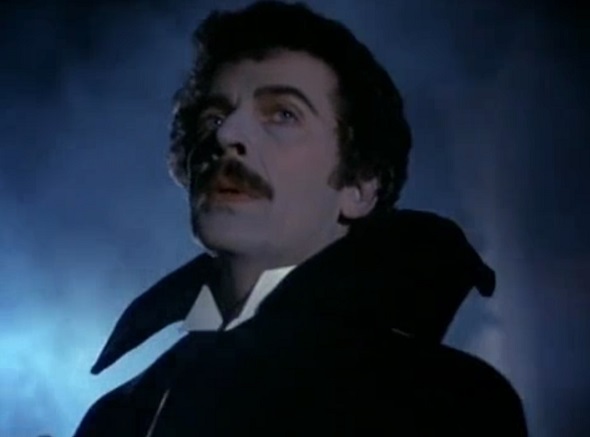
Mike Bradula: Surrounds himself with a large brood. A strong preference for wide lapels and a-frame residences. Prone to dispensing trite moral lectures when confronted, but turns surly when typecast.
Recommended listening: The UHF abyss gazes also.
“The Nice Price” was a late 1970s branding initiative by CBS Records, where perennial backcatalog faves got badged and repriced as midbudget offerings.
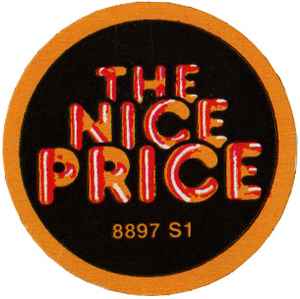
Nearly all of my old Clash tapes and CDs sported the sticker when I bought them. The copy of Combat Rock that Maura scored for me somewhere still has its one on the plastic shrinkwrap. Alongside Warners’ similar “Super Saver Series” initiative, the The Nice Price was a boon for music fans of limited means in the 1980 and 1990s — providing one’s tastes ran at least a half decade behind the curve, which mine certainly did.
“That’s very interesting and all,” I head you asking, “but what does that have to do with ghosts and ghouls and other terrors that haunt our collective dreams?”
Well, did you know The Nice Price had its very own mascot?

Between the fluorescent orange of the discount stickers and CBS’s striking and instantly recognizable red block letters against a white spine trade dress for its tapes and compact discs, there doesn’t seem to be a compelling case for throwing a mascot into the mix — much less a hopped-up hellclown in search of human souls to harvest.
Yet “Red” existed. The sole saving grace of his blasphemous existence was that his reach was largely contained to point-of-sale promo material and print media, where the public could on average avoid having to associate his leering visage with This Year’s Model, London Calling, or Kings of the Wild Frontier…
…until it was decided — in a fit of cocaine-fueled art-directed apocalypticism common the the 1980s — to manifest the monster in the live action flesh through a series of TV spots.
BEHOLD, THE VIDEO NIGHTMARE MADE FLESH.

Recommended Listening: For what shall it profit a man, if he shall gain a cassette copy of Screaming for Vengeance for $4.99, and lose his own soul?

This is the season when dead things spring back to a horrid semblance of life, right?
Recommended listening: The heavy, heavy monster sound.